Cartoonist Ali Dorani fled Iran at the age of 21 before being trapped in Australia’s controversial Manus Island detention camp for four years. Things changed after his artwork was posted online. This is his story as told to Muralidhar Atchutanna. Muralidhar is an artist and caricaturist based in Vijayawada and had been in touch with Ali Dorani over the past several months.
*
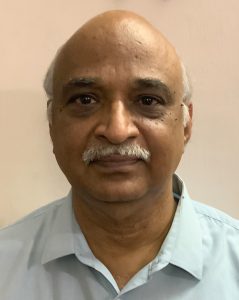 A small pufferfish, known for its art in the seabed, was attracted towards the wonderful colours of the Great Barrier Reef of Australia. It started its marathon swim from the Persian Gulf waters. Little did it know the dangers from predators or that the waters are different across the planet. It crossed the Persian Gulf, the Arabian Sea and swam across the major portion of the Indian Ocean and stopped at Indonesia for a while. It renewed its journey towards its destination, joined now by more fish.
A small pufferfish, known for its art in the seabed, was attracted towards the wonderful colours of the Great Barrier Reef of Australia. It started its marathon swim from the Persian Gulf waters. Little did it know the dangers from predators or that the waters are different across the planet. It crossed the Persian Gulf, the Arabian Sea and swam across the major portion of the Indian Ocean and stopped at Indonesia for a while. It renewed its journey towards its destination, joined now by more fish.
Then suddenly powerful sea-hawks encircled all the fish. The tiny pufferfish was stuck in the claws of a hawk. Mostly eaten up and with just a glimmer of life, the pufferfish was thrown away on the beaches. This “Eaten Fish” tried to move towards sea waters for re-birth, praying to God by creating impressions on the beach sand by moving its bones with the limited energy it had. God saw the suffering in the art and fulfilled the “wish of the fish”, the free life.
Confused?
This is the real and painful experience of a young refugee, who had drawing skills on one side and OCD (obsessive compulsive disorder) on the other. Ali Dorani left Iran clandestinely in 2013, to go to Australia. After reaching Indonesia, he tried for 40 days to go to Australia through a people smuggler. He risked his life by boarding into a clapped-out fishing vessel along with 150 fellow illegal immigrants. After a rainy and scary voyage of 52 hours, the Australian Navy intercepted them, and all were taken to the Christmas Island illegal immigrants’ detention centre. Dorani was now an illegal immigrant.
The circumstances and surroundings at the detention centre raised Dorani’s levels of OCD to a peak – he even washed the dictionary in a shower as he felt that it was dirty. He took no medicines, despite doctors’ prescription of medicines for his physical and mental conditions. He felt that Australian authorities may reject his application for asylum based on psychological disorders.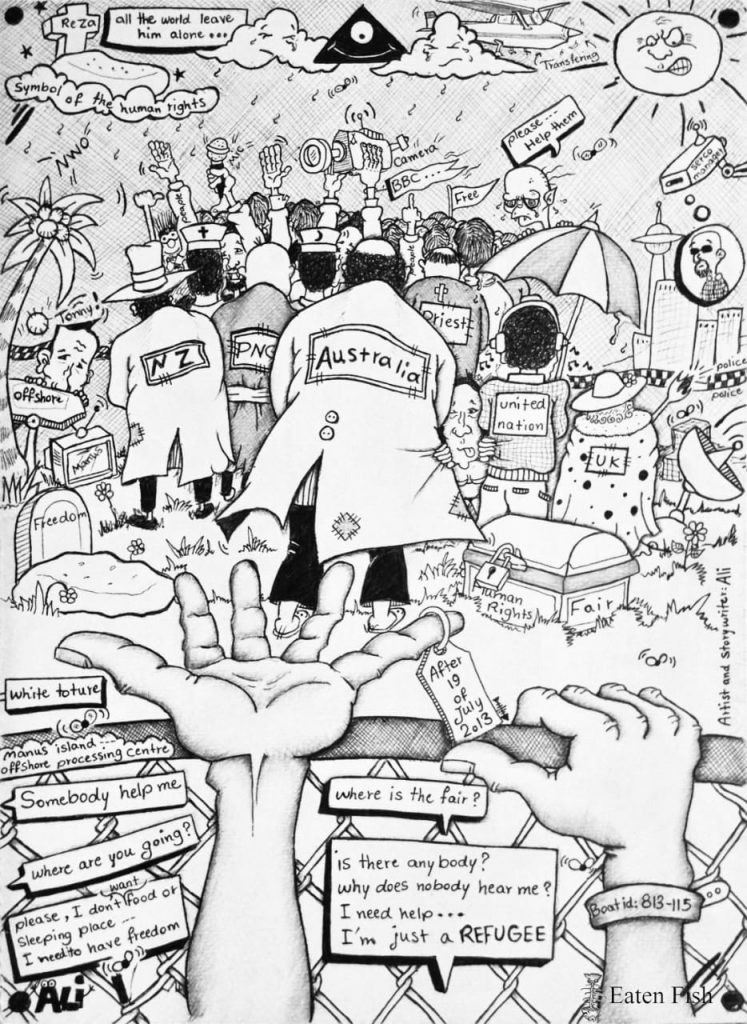
Dorani diverted his attention to drawing. He used to beg for materials like white sheets and pencils from immigration officers, who weren’t always in a giving mood. Hence, he was compelled to steal white sheets from language classes whenever the teacher was looking the other way. Scarcity is a good teacher – due to a scarcity of white papers, he had to be very careful and did not give any scope for mistakes and which improved his drawing skills further. He drew about the life in camps like lining up for food and what it was like using dirty public toilets. He showed his drawings to detainees and some of the immigration officers. His work on a white T-shirt showing “two eyes… crying on a map of Australia” and the words “I am only a refugee” drew the attention of two immigration offices and they enquired whether it was a protest. Though it was a casual drawing, he realised the importance of message through cartooning and its impact. He continued cartooning, receiving both positive and negative comments.
In January 2014, after 6 months of stay in Christmas Island, Dorani was moved to Manus Island – a tropical island which made his life miserable as it was very hot and difficult to breathe. Tents, dirty rooms and toilets, horrible showers were the way of life. Hundreds of people were crammed in a small camp. While shifting to Manus Island, the immigration officers took away his pencils.
Mosquitoes, bad weather, poor sanitation, OCD, crowed camp, no resources to draw – could life get worse? Yes, it could. One day locals attacked the camp and smashed everything and they beaten-up the people which resulted in death of one of the refugees.
This incident resulted in a change of management at the camp. There were some positive changes like improvements in dining room, introduction of English classes and drawing activities. Eaten Fish, Dorani’s pen name, started drawing again. He depicted the life of the camp, mosquitoes, sun, and rain in his works. In some of his works, he refers to the graves of refugees who died while they were in the camp. Sexual harassment and sexual assault problems in the camp were also depicted in his works.
Initially these cartoon works could not be shared to outside world as there was no internet, but later internet was allowed for 45 minutes for a week. Despite slow internet, he tried to contact Australian humanitarian groups through Facebook by sending friend requests to each member of the group and sent messages to thousands of FB members which yielded nothing.
However, his works attracted the attention of Australian workers and immigration officials at the camp and through them to human rights activist Janet Galbraith. She contacted him on Facebook, and she assured him that his works would be displayed in her gallery in Melbourne. In the absence of scanners and cameras, Eaten Fish secretly managed to take a photograph of his drawing using a mobile phone and sent the image to Janet Galbraith. As promised, his work was displayed in the gallery and surprisingly his work was identified by an official who works in Manus Island. He assured Janet Galbraith to help in bringing out the other works of Eaten Fish. He took photos of the cartoons by Eaten Fish and shared with Janet Galbraith. The cartoons were also published by several news organisations.
Even so, life did not change in the camp. In 2015 many of detainees went on hunger strike against Australia’s policy and conditions at the Camp. Eaten Fish’s health deteriorated drastically and after treatment for one month he contacted Janet Galbraith and explained the ordeal.
Further, he also contacted Cartoonists Rights Network International (CRNI) and Guardian Cartoonist “First Dog on the Moon”. The Guardian started publishing Eaten Fish’ cartoons and in 2016 CRNI gave him the ‘Courage in Editorial Cartooning’ award. While he got a lot of publicity for his cartoons and his sufferings in the camp, Eaten Fish never dreamt that his works could get him out of detention.
Artists around the world started drawing cartoons to show their support to Eaten Fish. Cartoonists of Washington Post, New Yorker and New York Times drew cartoons about Eaten Fish. ICORN (International Cities of Refuge Network) a Norwegian humanitarian organisation that helps Writers & Artists, took-up his case.
One day, in the hospital after 22 days of hunger strike, Eaten Fish received a welcome message from Norway’s Immigration Department. One fine day, Eaten Fish stepped into a plane with his god, Janet Galbraith.
Freedom.
After many years of suffering in detention camps, freedom was only a dream. And when that dream became a reality, Dorani could only cry for hours on that plane.
Eaten Fish is now free.
***
I contacted Eaten Fish through Facebook Messenger and asked some questions about his present life and effects of past. In his own words “Life after Manus Island was pretty hectic for me. In the first year I was so confused, and freedom gave me so much depression. I had to live by myself, so it felt weird living by myself after 5 years in prison. Because of PTSD (Post-traumatic stress disorder) I had to see a psychologist almost every two weeks. I was very suicidal the first months after I came to Norway.
But life goes on. In the past could of years I have been travelling a lot to different countries.
I have been visiting so many students in Norway and from different countries and telling them my stories about immigration prison camps in Papua New Guinea and Australia.
I have had many shows in different cities in Norway and in other countries such as Germany and Sweden. I have a huge audience now. Over 15000 people and students have visited my galleries, talks and conversations.
It’s unbelievable for people hearing about persecution of human beings inside Australia’s borders. Most people know Australia is one of the freest countries in the world, but they don’t know about immigration centres in Australia, and they don’t know what the Australia government is doing to hundreds of children by keeping them behind the fences in prisons”
About the impact of his art on him and fellow detainees:
“I think, I have the right to say that art actually saved me. I started drawing cartoons in detention to try and control my illness. Eventually, cartoons saved my life. I genuinely believe that art can help bring peace, and I must look after my art and respect that. Eaten Fish survived four years in refugee detention with his cartoons, social media, and a network of activist friends.
While I was in detention on Christmas Island and Manus Island lot of people like my drawings but told me that wouldn’t get me anywhere. Some of the detainees asked “What are you going to achieve with this? You can’t help get us out of here with these drawings.”
Thanks to the cartooning, social media & humanitarian organisations, I am free.”
*

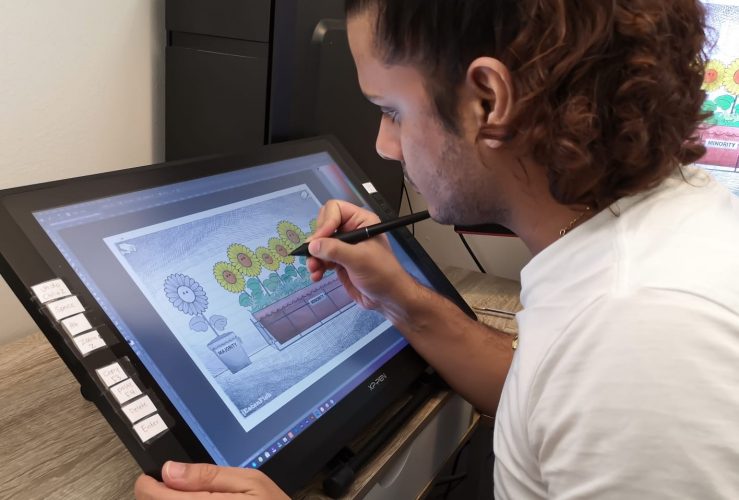


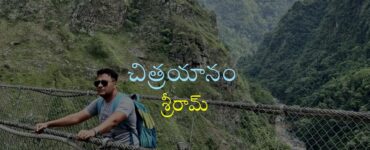
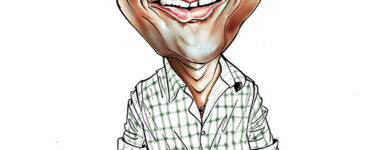
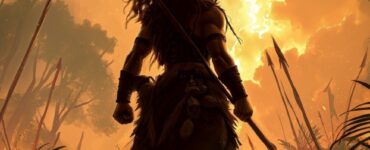
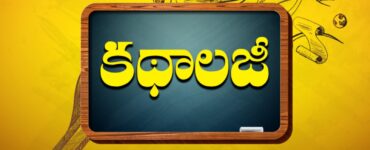
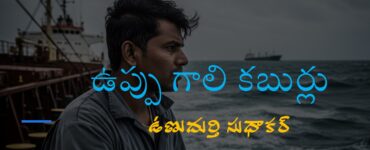
Very good story about cartoonist Ali Dorani.